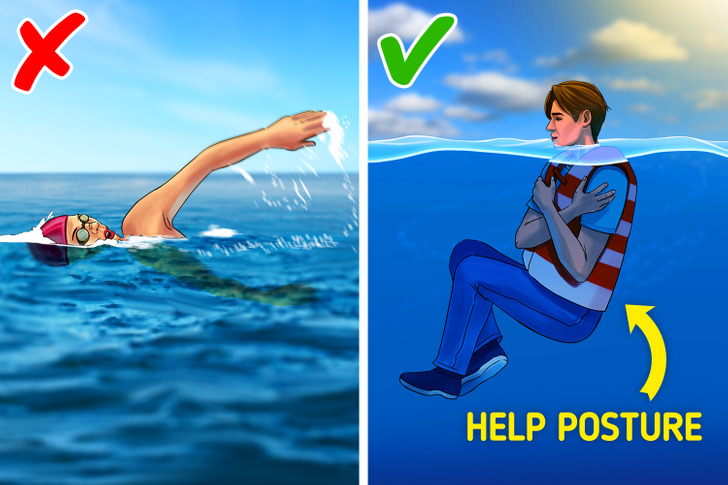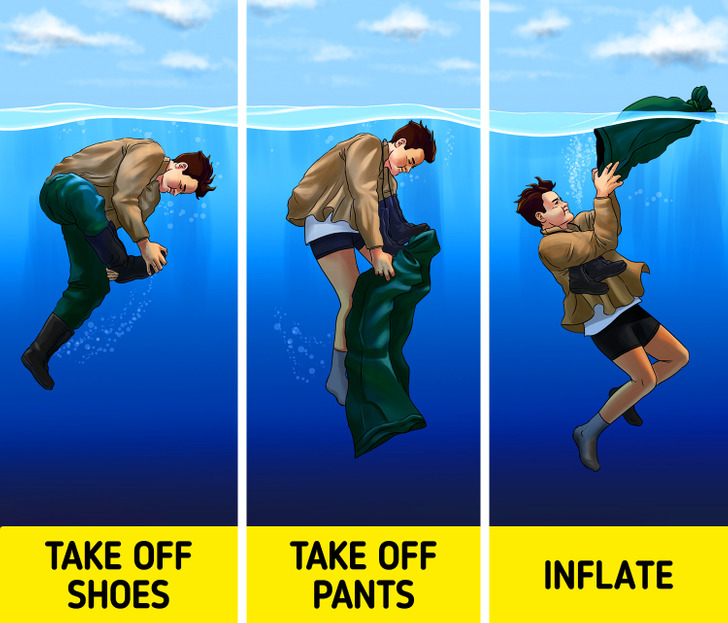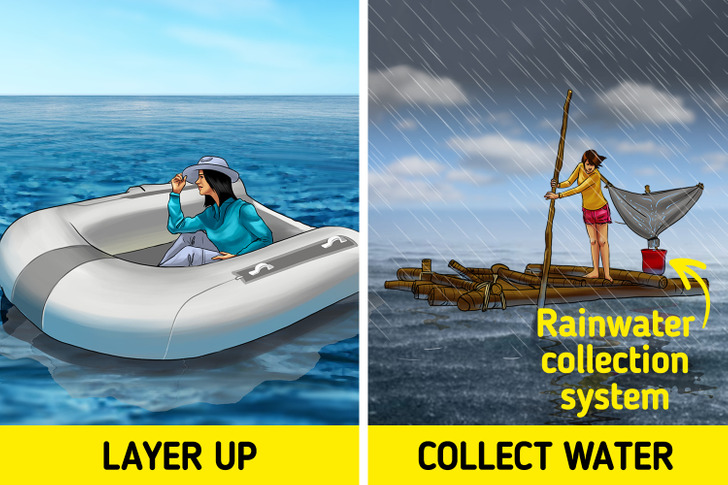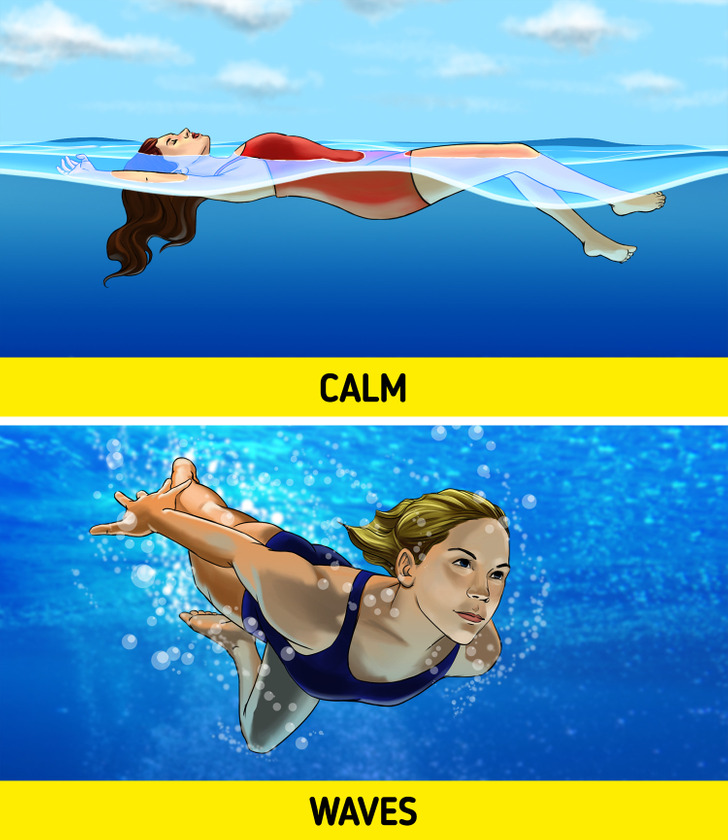What to Do If You Find Yourself in the Open Sea
Although different things may affect how long a person can survive adrift in the ocean, the first step is to stay calm, not panic, and gather your wits about you. There are plenty of survival tactics and ways to improvise life jackets as long as you’re wearing something, such as a pair of pants.
5-Minute Crafts is attempting to give you some sure-fire tips to survive if you find yourself alone in the middle of an open sea one day.
❗ This article is for informational purposes only and doesn’t replace professional advice. Avoid getting into dangerous situations!
1. If you have a life jacket on

If you’re adrift in the water and have a wetsuit or life jacket on, you can improve your chances of survival by following specific steps.
- Step 1: Don’t panic. Stay calm. It’s better not to wave your arms and legs around because it may cause fatigue, fast loss of body heat, hypothermia, etc. Swim only if you feel safe, have a floatation device on, or are not too far from the shore.
- Step 2: Apply the S.T.O.P. method, “stop, think, observe, plan.” Assess your situation, then make your next move. It’s normal to feel helpless if you’ve been in the water for about 6 to 9 hours. Increase your chances of survival by staying positive. Say to yourself, “I will survive today!”
- Step 3: Get into the posture called H.E.L.P., which stands for “heat escape lessening posture.” All you need to do is cross your arms and legs as compact as possible, then stay motionless. Don’t swim until the rescuers arrive. Move only when required. Remember that it’s easier for the rescuer to spot your brightly-colored life jacket.
❗Swimming isn’t advised because it may accelerate your body’s rate of heat loss. If you stay motionless, you maintain your body heat for 3 times longer. Also, the amount of heat our bodies lose in the water depends on the water’s temperature.
2. If you don’t have a life jacket but you’re wearing clothes

If there’s a raft around you, get into it. If not, you need to find something to float with or to keep you on the surface. You can still survive if you know how to convert your clothes into a flotation device.
- Step 1: Bend over, take off your shoes or boots, and tie their laces together. Then hang them around your neck.
- Step 2: Take off your pants and close the buttons or zippers to limit the airflow. Then tie the bottom parts of the legs together in a knot.
- Step 3: You need to sink about 2 feet (60 centimeters) below the water’s surface. After that, blow air into the pants. Repeat it until the pants are inflated. Keep the waistband underwater and tie it with your shoelaces to prevent air from escaping.
- Step 4: Loop it around your head and ’’hug" the pants with the fly facing your body. Finally, go into the H.E.L.P. posture. Stay still until the rescuers arrive.
3. If you are adrift on a boat or a raft

This is considered one of the best scenarios. Your boat becomes a shelter and a safe place to rest, not only for you but also for the rescuers who can locate it from the water and the air. Therefore, always stay with it if possible.
- Step 1: You need to act quickly. Ensure your boat isn’t wet. Since a lot of heat escapes from your head, cover it first. If you have a sleeping bag, you’re lucky. If you don’t, layer up with clothes. To keep your body heat, do tiny movements and exercises. If it’s hot, stay away from the sun. If you feel hot, you can wet your clothing.
- Step 2: Stay hydrated, but don’t drink salty seawater. Opt for various ways to produce drinkable water, such as a customized tarp or raincoat rainwater collection system. Or simply use your clothing to absorb rainwater and wring it out.
- Step 3: If you don’t have any food, you can rely on fish, plankton, seaweed, shrimp, crabs, seabirds, etc. You can create fishing equipment using shoelaces, string, thread, or cords. Hooks can be made from aluminum cans, screws, or nails. Don’t make splashes, as you may attract sharks.
- Step 4: If you see the shore within the distance, paddle. If you can’t control where you go, rely on the current; it may take you to land. The sun sets in the west, and birds head for in the land’s direction at night. Listen to the waves crashing or hitting — you may find an island this way. You can use a flare gun to signal ships or planes or get something shiny, like a piece of mirrored glass.
❗Remember, our bodies require at least a liter of water a day to survive, and your body needs more water than food.
4. If you’ve got no life jacket, clothes, or a boat

If you find yourself in the water without any proper clothes or life jackets, you still have a chance of survival.
- Step 1: Depending on your body’s form, you can tread the water. If you bear an average weight and are generally fit, you can tread water for up to 4 hours without a life jacket and for up to 10 hours if you’re fit. You’ll need to make more of an effort to keep yourself afloat if you’re heavy.
- Step 2: If there are constant waves and the water is calm, stay still. Lie on your back and keep your head above the waterline. Then float on the water. Wait until help arrives.
- Step 3: If there are rough waves, stay calm, and do a survival float. Rest face down and stomach-side down in the water, allowing your body to float. Keep the back of your head above water, and lift it when you want to inhale. Slowly exhale underwater. Repeat the process.